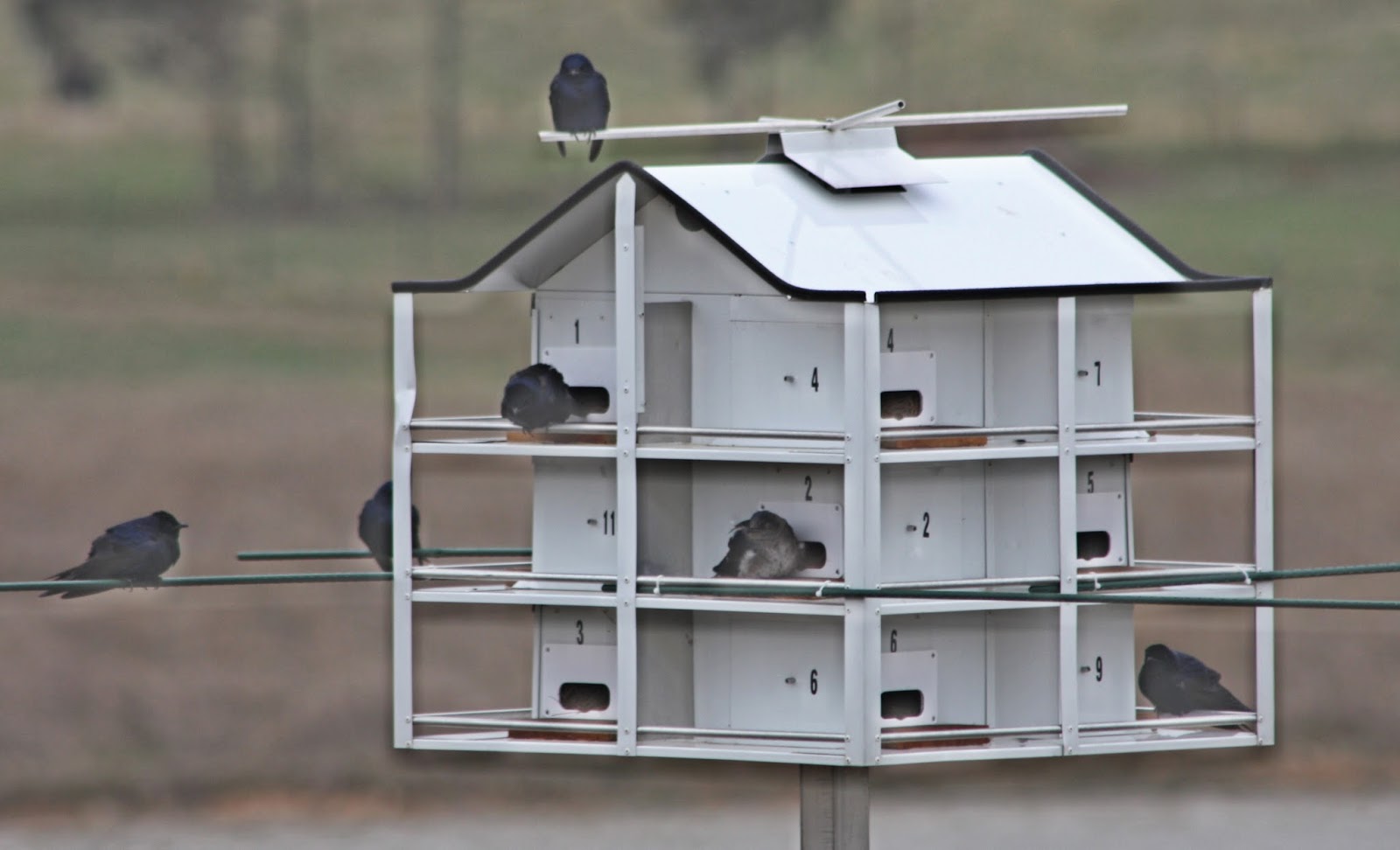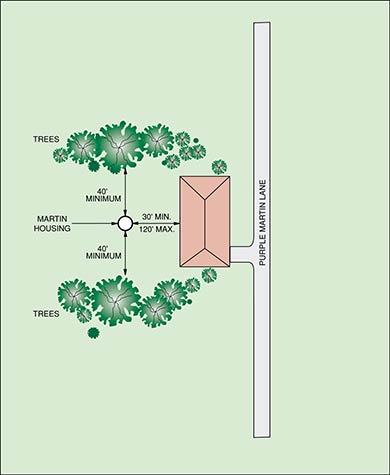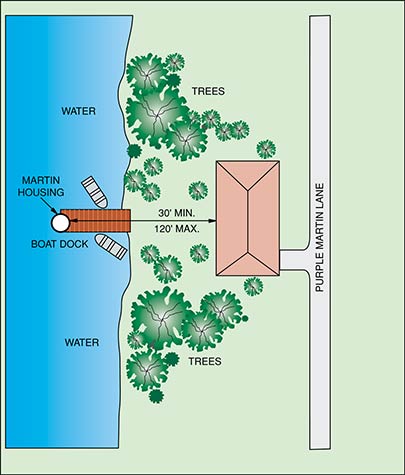Every year many purple martin colonies have to deal with the inevitable hawk and owl attacks and the losses of their martins. Hawks and owls are both protected by the
Migratory Bird Treaty Act therefore, only passive measures can be used to protect your colony. Shooting, harassing or any activities that cause harm to these species is illegal.
As colonies grow, so does the noise level as the martins sit out in the warm sun and socialize - loudly - with each other. The pandemonium of 150 chattering birds competing for mates will inevitably draw the attention of any airborne predators in the area. Placing your colony in the most wide-open area with trees at least 40 feet away, will help your martins escape most attacks. However, the further the trees are from your colony, the better their chances of reaching safety quickly.
Dealing with Hawk Attacks
During the early spring, my colony is frequently attacked by a very fast, hypersonic
Sharp-shinned hawk. Many people find it difficult to distinguish between a Sharpie and a Cooper's hawk, but once you have observed both of them in your backyard, you will be able to quickly tell the difference between the two. When my local
Cooper's hawk arrives, she will claim the territory for herself and the Sharpie will leave. That will present its own set of problems, but at least the Cooper's hawk is only capable of supersonic speed. One year, the Sharpie attacks were happening so frequently that I decided I better come up with a solution before she inflicted too much damage on my colony.
While watching my birds at the feeder one day, I noticed all the birds suddenly flush into the nearby brush piles and shrubs for cover. I held my breath as my Sharpie executed a blistering attack, but still came up empty-clawed and landed on the branch of my dead cedar tree to regain her composure.
 |
| Sharp shinned hawk - December, 2012 |
Overcome with joy that she had missed breakfast, I opened the window, blew her a big raspberry and snapped her photo as she gave me the evil stink-eye. As I watched her perching there, I realized that all the attacks on my colony had come from the tree lines on three sides of my property. Even though the trees are over 150 feet away on all sides, she was still trying every trick she knew to grab a martin, coming in very low then suddenly popping up or under a tree to attack the colony.
Since the birds at my feeders tend to be much more watchful for predators than my noisy martins who sometimes get rather caught up in their social gatherings, I decided to setup bird feeders on the north, west and east sides of my
property, right in the hawks' attack paths, between the tree lines and
my martin housing. The idea of this strategy was that the birds at the feeders would attract the attention of the hawk as he/she came through and would be distracted just long enough for the martins to hear the alarm and escape.
As doves are purported to be a Cooper Hawk's favorite meal, I also attached dove decoys to the tops of each feeder and added shrubbery and brush piles nearby so the birds at my decoy feeders had plenty of cover to dive into, if a hawk attacked. My plan worked. The Sharpie and the Cooper's were both attracted to the activities at the feeders as they executed their attacks and since my dove decoys couldn't fly, they were attacked relentlessly.
 |
| One of my dove decoys stationed on top of a bird feeder. This feeder is 100' to the west of my racks and the tree line is 125' more feet to the west of it. Nope, nothing fancy here - just a piece of wood, some electrical tape and a hapless dove decoy bracing himself for the next attack. |
As an added bonus, the alarm calls of the birds at the feeders caused my martins to launch themselves into the air - a much safer place for them to be during an attack.
For added protection, I also added 14 purple martin decoys to the perches around my colony and I move them around to different positions when I conduct nest checks. These decoys and the strategically placed feeders have helped immensely with protecting my colony.
Dealing with Owl Attacks
Owls are another challenge that Purple Martin Landlords frequently have to deal with. Owls find martin colonies by hearing the martins vocalizing
and making other noises at night in their nests. Owl guards must be placed on
houses and gourds to keep owls from spooking martins from their nests or from
actually reaching inside and grabbing a martin. A Great Horned Owl (GHO) can have an 8-12 inch reach and quickly devastate your colony in a matter of 2-3 nights. As a first line of defense, landlords can add tunnels to the
entrances of each nest. Larger cavities and/or extending the entrances will also help protect your martins from other aerial predators such as accipiter hawks,
falcons, crows and even Blue Jays. Check out this article on how to modify your housing if you are experiencing owl attacks on your colony.
http://www.purplemartin.org/forumarchives/archive/Owlreach.htm
You can also add hardware cloth cages to any housing or gourd racks. Ideas and pictures are described in these linked posts / articles:
http://www.purplemartin.org/update/Mod.html
And more pictures and ideas from the PMCA Forum:
http://purplemartin.org/forum/viewtopic.php?t=21912&highlight=aprils+owl+guards
After losing 20+ birds to owl predation in 2012, Jerry, one of my landlord friends here in Missouri, got very creative and came up with his own homemade ideas and has offered to share his pictures and the descriptions of his materials in his creations below.
 |
| In 2012, Jerry Heitman in Troy, MO lost 20+ birds due to owls. In 2013 he estimated that he
only lost 1 bird, after installing the owl guards pictured here. |
 |
| These guards are made of # 9 fence wire and a 3" piece if
1/2" electrical conduit smashed around the wire. |
 |
| Jerry's site with the owl guards installed |
Everyone's colony will eventually experience a hawk, owl, snake, raccoon or other type of predator attack. The best line of defense is to ensure that you've given your martins the best chance of survival and the ability to evade these predators. A hungry hawk or owl can wreak havoc on your colony, so it is best to be prepared in advance and establish a safe nesting site for our friends.
Answers to the Trivia Questions asked here:
http://kathyfreeze.blogspot.com/2014/03/attraction-techniques-for-new-sites.html
1.
c
2. b
– According to the
PMCA site, the average age for martins is 2-5 years, with some living 6-7 years; the
oldest martin on record lived to be 13 years and 10 months.
3. a
– In 2008, researchers, working in collaboration with the PMCA, equipped 20
purple martins with geolocators (tracking devices,
small and light enough for songbirds to carry).
They mapped their round trip journey from Pennsylvania to the Amazon basin and back –
a trip of about 9,300 miles. The birds' travel speeds astounded them. All flew two to
six times faster during their spring return journey than in fall. One female
purple martin dashed back north in 13 days at a speed of about 358 miles a day,
shattering previous estimates for songbirds of 93 miles a day.
4. d
5. a,
c, d – It is an old wives’ tale that opening a birds’ nest and inspecting the
young or eggs will cause the adult parents to abandon the nest. In fact, conducting weekly nest checks of
your birds’ nests will help you correct problems that may save many fledglings
who otherwise might not have survived.
As the English house sparrow is a ferocious nest site competitor, allowing it
to nest in your housing will either prevent martins from establishing a colony
at your site, or will cause them to eventually abandon. Any devastating attacks on your colony such
as a raccoon or snake attack can also lead to abandonment of your site.
























